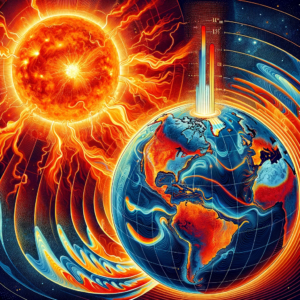The Phenomenon of Solar Flares and Shortwave Propagation
TL;DR:
Understanding the dynamics of solar flares and their impact on shortwave radio broadcasts is crucial for those who rely on these signals for communication and broadcasting. The sunspot cycle and SSN are critical predictors of solar activity and, consequently, shortwave radio propagation conditions. As we continue to observe and study these solar phenomena, we can better prepare for and mitigate the effects of solar flares on shortwave radio communications.
Solar flares, intense bursts of radiation from the Sun can significantly impact shortwave radio broadcasts on Earth. These flares occur when magnetic energy built up in the solar atmosphere is suddenly released. The energy from a solar flare can disrupt the Earth’s ionosphere, a layer of the atmosphere crucial for shortwave propagation. When solar flares happen, they can cause sudden ionospheric disturbances (SID), leading to degraded or completely blocked shortwave radio signals, a phenomenon often referred to as “solar flare and radio disturbances.”
Solar Flares and Radio Disturbances
The relationship between solar flares and radio disturbances is complex. Shortwave radio waves travel long distances by reflecting off the ionosphere. During a solar flare, the ionosphere’s density and composition change rapidly, causing shortwave signals to be absorbed rather than reflected. This can lead to shortwave radio blackouts, significantly weakening or losing transmission. Such occurrences are often termed “solar flares and radio blackouts.”


Solar activity, particularly solar flares, can significantly impact shortwave radio propagation, likely contributing to the issues you’re experiencing with broadcast reception. The National Oceanic and Atmospheric Administration’s (NOAA) Space Weather Prediction Center provides detailed and current information on space weather conditions that affect radio communications. The NOAA website provides various resources, including forecasts, reports, and models that track and predict solar activity and its impact on different aspects of space weather, including HF radio communications.
Solar flares emit X-rays that can penetrate the Earth’s ionosphere, particularly the D-layer, causing it to become more ionized. This increased ionization can reflect or absorb radio waves at different frequencies, leading to HF (High Frequency) radio communications disruptions. This is particularly problematic for frequencies in the 1 to 30 MHz range, commonly used for shortwave broadcasting. The impact of these solar flares is most intense on the Earth’s dayside, where the sun is directly overhead, and can cause radio blackouts.
Moreover, other space weather phenomena like Radiation Storms caused by solar protons can also disrupt HF radio communication. These protons, guided by Earth’s magnetic field, collide with the upper atmosphere near the poles, enhancing the D-Layer and blocking HF radio communication at high latitudes.
Sunspot Cycle and Its Influence
The sunspot cycle, approximately 11 years, significantly influences shortwave radio propagation. Sunspots, dark spots on the Sun’s surface, are indicators of solar magnetic activity, which can lead to solar flares. During periods of high sunspot numbers (SSN), the Sun is more active, increasing the likelihood of solar flares. High SSN usually means better shortwave propagation conditions due to a more reflective ionosphere, except during solar flares. Understanding the “sunspot cycle” is essential for predicting shortwave radio propagation conditions.

SSN (Sun Spot Number) and Shortwave Propagation
SSN, or Sun Spot Number, is a simple count of the number of sunspots and groups of sunspots visible on the Sun’s surface. A higher SSN indicates a more active Sun, which can enhance or disrupt shortwave propagation. Increased solar radiation can boost the ionosphere’s reflectivity during a high SSN period, improving shortwave signal reach. However, the increased solar activity also raises the risk of solar flares, which can cause shortwave radio blackouts. Therefore, the relationship between SSN and shortwave propagation is a delicate balance.

0 Comments